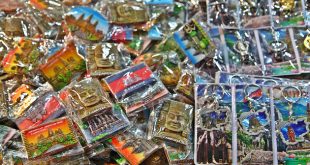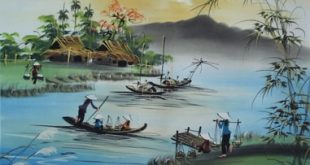Dong Ho Painting In Vietnam
Dong Ho Painting or its full name Dong Ho folk woodcut painting is a genre of Vietnamese folk painting, dated back from over 300 years ago at Dong Ho village, Dong Ho commune, Thuan Thanh district, Bac Ninh province. It was a must-have thing that the Vietnamese people brought in their Tet Holiday, hung up in their house and only replaced by a new one when the New Year was coming.
The most unique feature of this line of painting is overall natural materials. Its printing paper is hand made of bark of a tree named “Dzo” (Giấy Dó), powder of seashells and sticky rice pastes (Hồ nếp). The background is often white whilst the rest colors are refined from various materials of tree leaves or flowers that the Vietnamese can find out and make them everywhere. For example, black is taken by burning bamboo’s leaves, glitter white is from seashells, yellow is from sophora japonica, green is from cajeput leaves and red is from red gravel. The long-standing durability of colors is protected by covering a layer of sticky rice paste after finishing draw.
The themes of the painting are for a real reflection of villages, cultural and historical values and wishes of luck and happiness in daily life on Tet occasion. Some famous paintings tell mythical and historical stories such as Ba Trieu, Hai Ba Trung, Quang Trung and Thanh Giong as well as folk allegories stories like Truyện Kiều (Kieu Tale), Thach Sanh, Thầy đồ Cóc (Confucian scholar in form of a toad) and Đám cưới chuột (Rat’s wedding). Some reflect the local peoples’ wishes of prosperity, happiness and luck named as Lợn đàn (Corpulent pig with suckling piglets), Gà đàn (hend surrounded by chicken); and Cá chép (Carp). The rest describes social activities and commentaries such as Đánh ghen (Sense of Jealously), Hứng dừa (Scene of catching coconuts) or Chăn trâu thổi sáo (Boy sitting on a buffalo and playing flute).
Nearby, some Dong Ho paintings displayed in couple or quartet, which is aimed to express fully the signification of the set, for example the couple paintings: the Vinh Hoa (Eminence) and the Phú Quý (Prosperity and Honour). Visitors now go to Dong Ho village to witness and learn more information of how old craftsmen make a traditional Dong Ho folk painting.




